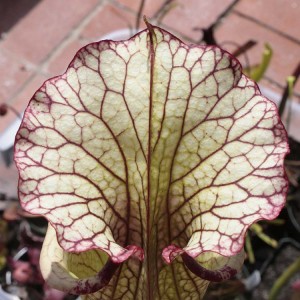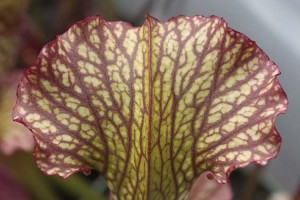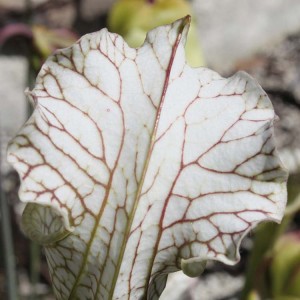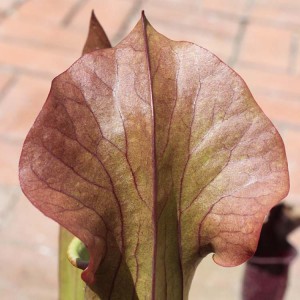
Today I feature some striking pitcher plant leaves to mark the occasion of April’s Foliage Follow-Up, the blog meme begun by Pam of Digging.
The story goes that the early settlers mistook the carnivorous trumpet-shaped leaves for flowers. And how could you blame them? These tall tubes formed from modified leaves feature interesting shapes and colors in the green-yellow-white-pink-red range, often with the colors forming striking patterns. They’re easily as interesting as most flowers.
Botanist Donald E. Schnell writes in Carnivorous Plants of the United States and Canada, “there seems to be nothing subtle about pitcher plants. Their general appearance begs attention, and when we encounter them we are almost startled. But once we look for awhile, then wander among them, we can begin to peel apart layers of subtlety and see many little secrets that collective fit these plants so neatly into their bog habitat–and we still do not know all their secrets.”
Schnell has divided the carnivorous pitcher leaf into 5 different zones, each with a different morphology. The scary insect-eating and -digesting carnivory takes place down in zones 3 and 4, the lower parts of the pitcher. But these photos concentrate on the backs of the top lid of these pitchers, the entire lid being what Schnell calls zone 1.









Even though my sarracenia plants get to live in a cushy USDA Zone 10 garden (not to be confused with the zones of a sarrecenia pitcher), their internal clocks seem more tuned in to seasonal cycles of daylength or relative temperatures than to absolute temperatures. Most of the species and hybrids have been suspicious of San Diego’s warm climate and keep their flowers and foliage developing in the rhizomes all winter. Only now are most beginning to bloom and send out leaves, though maybe a little bit earlier than in the American Southeast, where these plants originate.
As the season progresses, these leaves will often develop different colorations. The veins in some will grow more pronounced, some pitchers will go all-red, others will show a golden underglow. The brief burst of spring flowers in these plants is great, but the foliage makes for months of really cool leaf-viewing.
For all sorts of other foliage happenings in the garden world, check out the links in this month’s Foliage Follow-Up post at Digging. Thanks for hosting, Pam!

I had no idea those were the leaves, I assumed that was the flower. I love a post where I can learn something new and be entertained at the same time.
I didn’t know these were leaves either! Cool. These plants are really amazing. Are these the ones that can “eat” small animals – or am I thinking of something else?
Wow! Those photos are beautiful. They are amazing plants. This post was quite interesting!
Great photos. I’m impressed, I barely managed bloom day, never mind a follow up. Looks like the rains have really helped your carnies along.
Hi Janes
Great to connect with you. There is a species of pitcher plant that grows in Canada. It’s Sarracenia purpurea and it’s the official flower of the province. So it’s one that can take the cold and wind. I’ve had the good fortune to seen large spreads of them when on a hike in Newfoundland. I remember thinking that they must be very well feed, as the mosquitoes in the boggy area were big and hungry. The leaf veins look like blood veins, appropriate don’t you think.
I find it fascinating. There a few other plants that I can think of that have prettier foliage then flowers. Isn’t nature great?
Pitcher plants have a certain sinister glamor, don’t they? What a great plant to focus on for Foliage Follow-Up. Thanks for joining in, James.
Looking at them your way, the leaves almost resemble heucheras. Very interesting perspective, but i miss seeing the architecture of the whole plant.
I’m another one that thought the pitcher was the flower – lol. I imagine a lot of people think that. I also didn’t realize there were so many different color variations. I am going to have to examine them more closely next I see them at a plant show.
I miss having Sarracenias, but I don’t miss forgetting to buy distilled water! Can rainwater be harvested as an alternative? I’d love to start a collection of native carnivores- keep meaning to go to the nursery we have up here that specializes in them.
Debbie, I have a hard time believing they’re leaves, too, since they’re so weird and wonderful…
Wendy, these guys are carnivorous plants, so they’ll dine on mostly insects. For me the pitchers seem to attract flies most.
FLoridagirl, I’m glad you enjoyed the post. I really like sharing my excitement in some seriously cool plants.
gardener, I have a couple hybrids that use the Canadian species as one parent, but the plant itself has a reputation for not doing well in warmer climates like mine. Apparently it’s so common and interesting a plant that it’s the floral emblem of Newfoundland and Labrador. The red veins do seem to belie its carnivorous ways.
Noelle, as you point out many plants are known primarily as “foliage plants” since their leaves so outshine any flowers they might have. Or in the case of more ancient plants like ferns, they don’t flower at all…
Pam, yes, I think the plants strike a somewhat uncomfortable balance between being stunning and creepy. It definitely adds something to their mystique.
Ricki, I agree that the most amazing structures of these plants are the pitchers. Each part of the pitcher seems to have its own interesting patternings, with the lids having some of the splashiest coloration.
Melody, definitely take a closer look next time you see any of these plants. They’re really complex things to study–and actually surprisingly easy to grow given lots of sunlight and lots of water.
Christine, I give my plants rainwater when I can. I have about eighty gallons saved up now, but I’ll go through all that and have to make some filtered water for them when we enter our long and dry summer. There are some California sundews (drosera) that should be pretty easy to grow, along with some aquatic species (utricularia). And then there’s the spectacular cobra lily, Darlingtonia california, which unfortunately is a fairly difficult plant for may people who’ve tried to grow it, myself included.
Those are beautiful!
Very nice Sarracenia there! My favorite carnivore 🙂